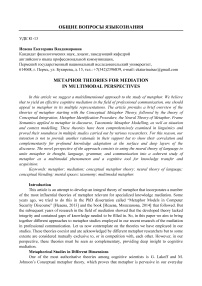Metaphor theories for mediation in multimodal perspectives
Автор: Isaeva E.V.
Журнал: Евразийский гуманитарный журнал @evrazgum-journal
Рубрика: Общие вопросы языкознания
Статья в выпуске: 3, 2021 года.
Бесплатный доступ
In this article we suggest a multidimensional approach to the study of metaphor. We believe that to yield an effective cognitive mediation in the field of professional communication, one should appeal to metaphor in its multiple representations. The article provides a brief overview of the theories of metaphor starting with the Conceptual Metaphor Theory, followed by the theory of Conceptual Integration, Metaphor Identification Procedure, the Neural Theory of Metaphor, Frame Semantics applied to metaphor in discourse, Taxonomic Metaphor Modelling, as well as situation and context modelling. These theories have been comprehensively examined in linguistics and proved their soundness in multiple studies carried out by various researchers. For this reason, our intention is not to provide another rationale in their support but to show their correlation and complementarity for profound knowledge adaptation at the surface and deep layers of the discourse. The novel perspective of the approach consists in using the neural theory of language to unite metaphor in thought, language, grammar, and communication into a coherent study of metaphor as a multimodal phenomenon and a cognitive tool for knowledge transfer and acquisition.
Metaphor, mediation, conceptual metaphor theory, neural theory of language, conceptual blending, mental spaces, taxonomy, multimodal metaphor
Короткий адрес: https://sciup.org/147235357
ID: 147235357
Список литературы Metaphor theories for mediation in multimodal perspectives
- Исаева Е. В., Мишланова С. Л. Метафорическое моделирование разных типов знания в дискурсе компьютерной безопасности. Пермь: Изд-во «Пермский государственный национальный исследовательский университет», 2014. 171 c.
- Исаева Е. В. Модели метафоры в дискурсе компьютерной безопасности. Пермь: Изд-во «Пермский государственный национальный исследовательский университет», 2013. 238 c.
- Ковальчук Л. П. Теория концептуальной интеграции Ж. Фоконье и М. Тернера // Филологические науки. Вопросы теории и практики. 1 (8). Тамбов: Грамота, 2011. C. 97-101.
- Christensen D. Beyond Virtual Vaccinations // Science News. 31.07.1999. 156 (1). Р. 76-78. Retrieved from Corpus of Contemporary American English. URL: https://www.english-corpora.org/coca/ (дата обращения: 17.07.2021).
- Dijk T. van Cognitive Situation Models in Discourse Production: The Expression of Ethnic Situations in Prejudiced Discourse // Language and Social Situations / Forgas J. P. New York: Springer: Springer Series in Social Psychology, 1985. P. 61-79.
- Fauconnier G., Turner M. Blending as a central process of grammar // Conceptual structure, discourse, and language / Goldberg A. Standford: Center for the study of language and information, Cambridge University Press, 1996. P. 113-130.
- Feldman J. A. From Molecule to Metaphor. A Neural Theory of Language. Cambridge, Massachusetts, London: The MIT Press, 2006. 262 p.
- Fillmore Ch. J. Frame Semantics // Linguistics in the Morning Calm: Selected Papers from SICOL-1981 / The Linguistic Society of Korea. Seoul, Korea: Hanshin Publishing Company, 1982. P. 111-137.
- Fillmore Ch. J. The Case for Case // To appear in Emmon Bach and Robert Harms, eds., Proceedings of the Texas Symposium, on Language Universals April 13-15, 1967 URL: https://files.eric.ed.gov/fulltext/ ED019631.pdf (дата обращения: 17.07.2021).
- Gostev A. Malware evolution: January - March 2008 // Securelist. AO Kaspersky Lab, 07.05.2008 -17.07.2021. URL: https://securelist.com/malware-evolution-january-march-2008/36208/ (дата обращения: 17.07.2021).
- Isaeva E. V., Crawford R. Semantic Framing of Computer Viruses: the Study of Semantic Roles' Distribution // Perm University Herald: Russian and Foreign Philology. 11 (1). 2019. P. 5-13.
- Isaeva E. Metaphor in Terminology: Finding Tools for efficient Professional Communication // Fachsprache. Journal of Professional and Scientific Communication. Archus: Facultas Verlags- und Buchhandels. 2019. Special Issue. Р. 65-86.
- Kaspersky. Malware & Computer Virus Facts & FAQs // Kaspersky. AO Kaspersky Lab, 2021. 17.07.2021. URL: https://www.kaspersky.com/resource-center/threats/computer-viruses-and-malware-facts-and-faqs (дата обращения 17.07.2021).
- Lakoff G. The Neural Theory of Metaphor // SSRN. Rochester: Elsevier, 2009. URL: https://papers.ssrn.com/sol3/papers.cfm?abstract_id=1437794 (дата обращения 17.07.2021).
- Lakoff G., Johnson M. Metaphors we live by. Chicago: University of Chicago press, 1980. 241 р.
- Oligschlaeger C., Richter E. Buyer's guide to virus protection software // Computer. 1991. 13 (10). P. 54-58. Retrieved from Corpus of Contemporary American English. URL: https://www.english-corpora.org/coca/ (дата обращения: 17.07.2021).
- Steen G., Biernacka E., Dorst L., Kaal A., Lopez-Rodriguez I., Pasma T. Pragglejaz in practice: Finding metaphorically used words in natural discourse // Researching and applying metaphor in the real world / Low G., Todd Z., Deignan A., Cameron L. Amsterdam: Benjamins, 2010. P. 165-184.
- Vergelis M., Scherbakova T., Sidorina T. Spam and phishing in Q1 2019 // Securelist. AO Kaspersky Lab, 15.05.2019 - 17.07.2021 URL: https://securelist.com/spam-and-phishing-in-q1-2019/90795/ (дата обращения: 17.07.2021).
- Zwaan R. A. Situation models, mental simulations, and abstract conceptsin discourse comprehension // Psychonomic Bulletin & Review.: Springer, 2016. 23. Р. 1028-1034. URL: https://link.springer.com/article/ 10.3758/s13423-015-0864-x (дата обращения: 17.07.2021).


